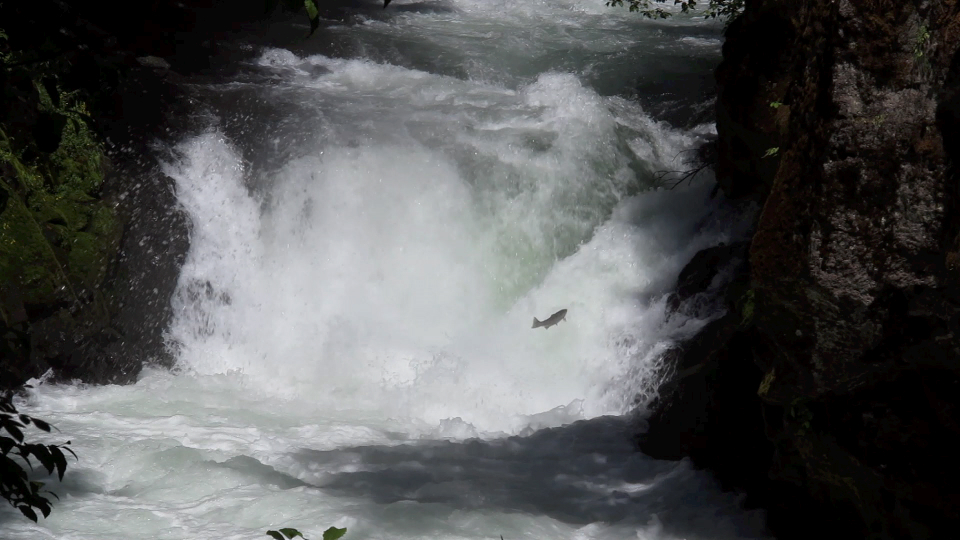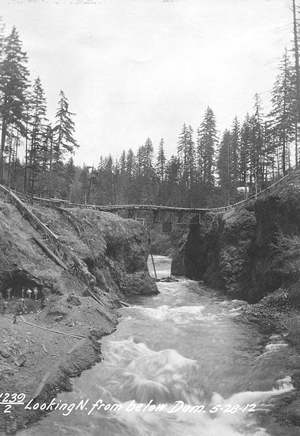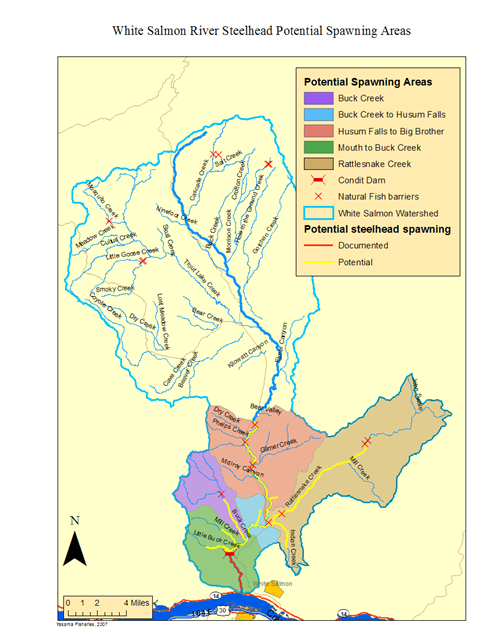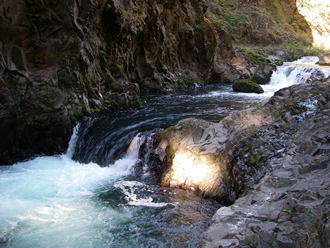The
White Salmon River Subbasin
 The
White Salmon River subbasin is part of the area ceded by the Yakama Nation to
the U.S. Government by treaty in
1855, and contains usual and accustomed hunting, fishing and gathering grounds,
as well as archaeological and cultural sites of tribal and national significance.
The Rattlesnake Creek site was added to the National Register of Historic Places
in 1978.
The
White Salmon River subbasin is part of the area ceded by the Yakama Nation to
the U.S. Government by treaty in
1855, and contains usual and accustomed hunting, fishing and gathering grounds,
as well as archaeological and cultural sites of tribal and national significance.
The Rattlesnake Creek site was added to the National Register of Historic Places
in 1978.
The
river is home to historical populations of Middle Columbia River steelhead,
Lower Columbia River Chinook, Lower Columbia River coho, Columbia River chum, Pacific and brook lamprey, bull trout, rainbow and coastal cutthroat trout. Currently the historical spring Chinook population is considered
extirpated, the historical steelhead, chum, fall Chinook and coho populations are
listed as threatened for protection under the Endangered
Species Act.
The
White Salmon River drains approximately 386 square miles in  southwestern Washington
and joins the Columbia River at Underwood, Washington at river mile (RM) 163. Abundance of
the subbasin's salmon and steelhead populations dropped significantly after
1913 when construction of Condit Dam at RM 3.3 on the White Salmon River blocked
all anadromous fish migration to, and most outmigration from, historical spawning and rearing grounds in
the upper watershed. The Yakama Nation, along with several other organizations
and agencies, is party to a settlement
agreement with PacifiCorp for the
removal of Condit Dam. The dam was breached in October 2011 (see Pacificorp's press release from June 14, 2011) and decommissioning, including removal of the dam structure, flow line and coffer dam, is expected to be completed in September 2012. Restoration activities, such as sediment stabilization and revegetation of the former reservoir will be conducted in the year after breach.
southwestern Washington
and joins the Columbia River at Underwood, Washington at river mile (RM) 163. Abundance of
the subbasin's salmon and steelhead populations dropped significantly after
1913 when construction of Condit Dam at RM 3.3 on the White Salmon River blocked
all anadromous fish migration to, and most outmigration from, historical spawning and rearing grounds in
the upper watershed. The Yakama Nation, along with several other organizations
and agencies, is party to a settlement
agreement with PacifiCorp for the
removal of Condit Dam. The dam was breached in October 2011 (see Pacificorp's press release from June 14, 2011) and decommissioning, including removal of the dam structure, flow line and coffer dam, is expected to be completed in September 2012. Restoration activities, such as sediment stabilization and revegetation of the former reservoir will be conducted in the year after breach.
A pilot project was undertaken in 2009 to determine the best methods for salvaging wild Lower Columbia "tule" fall Chinook below Condit Dam and transporting them above the dam in advance of its removal. The USFWS and WDFW with the Yakama Nation and other partners captured the tule fall Chinook in the lower river during the late summer and fall of 2011 and transported them to the river above Condit Dam to spawn naturally above the project area, and to get them out of the path of the release of sediment and water stored up behind the dam when it was breached on October 26, 2011. 679 tule fall Chinook (about 90% of which were wild) were transported to three locations between Condit Dam and Husum Falls upstream. In subsequent spawning surveys, approximately 180 redds were enumerated in this stretch of river.

- White
Salmon River fall and spring Chinook are included in the Lower Columbia
River Chinook salmon (Oncorhynchus tshawytscha) ESU, which was listed
as threatened on March 24, 1999.
- White
Salmon River coho salmon are part of the Lower Columbia River coho salmon
(O. kisutch) ESU, which was listed as threatened on June 28, 2005.
- White
Salmon River steelhead were originally listed as threatened as part of the
Middle Columbia River steelhead (O. mykiss) ESU on March 25, 1999.
After NMFS revised its species determinations for West Coast steelhead,
White Salmon steelhead were included in the Middle Columbia River steelhead
Distinct Population Segment (DPS), which NMFS listed as threatened on January
5, 2006 (71 FR 834).
- White
Salmon River chum salmon are part of the Columbia River chum salmon (O.
keta) ESU, which was listed as threatened on March 25, 1999.
The YN, in conjunction
with local, state and federal entities will help with reintroduction efforts
of anadromous fish to areas blocked to migration over the last 90 years by Condit
Dam. Access to up to 33 miles of steelhead and up to 14 miles of salmon habitat
is expected to be restored in 2012.
The restoration
of passage past the Condit Dam site presents a unique opportunity to
study the effects of dam removal on existing and functionally extirpated fish
populations. In its
review of FY '07-'09 project proposals submitted for funding consideration under
the Columbia River Basin Fish and Wildlife Program, the Independent Scientific
Review Panel (ISRP) for the Northwest Power and Conservation Council recommended
that "the Council pay close attention to the implementation of dam removals
in the Columbia Basin and ensure, perhaps through targeted research solicitations,
that dam decommissioning and post-removal effects are properly monitored."
The Yakama
Nation and other agencies are actively pursuing funding sources that will support
post- dam removal studies of both resident and anadromous fisheries
in the White Salmon River.

Additional
data on the White Salmon River subbasin can be found in:
- Yakama Nation White Salmon Subbasin Steelhead Spawners Surveys Summary 2012-2019 (March 2020)
- Juvenile salmonid monitoring in the White Salmon River, Washington, post-Condit Dam removal, 2016; Open-File Report 2017-1070 (USGS, prepared in cooperation with Mid-Columbia Fisheries Enhancement Group)
- Translocation of Lower Columbia River Fall Chinook Salmon (Oncorhynchus tshawytscha) In the Year of Condit Dam Removal and Year One Post-Removal Assessments--
2011 and 2012 Report (USFWS, 2013)
- Oregon Field Guide special "The White Salmon River Runs Free: Breaching the Condit Dam" (Oregon Public Broadcasting, Feb. 2013)
- PacifiCorp Condit webisodes:
- A Quick Glimpse Into the “New” Lower White Salmon River (WetPlanet Whitewater blog, mid-September, 2012)
- Time lapse footage of Condit Dam breach (October, 2011)
- compressed time lapse footage of dam breach and draining of Northwestern Reservoir (posted 10/27/2011)
- White Salmon time lapse Condit Dam decommissioning progress blog
- Condit Decommissioning
Schedule of Construction Activities (PacifiCorp, June 2011)
- FAQs about Fish Capture and Transport at the Condit Dam (U.S. Fish & Wildlife Service)
- Condit Dam Project Removal Decommissioning Schedule (more detailed; PacifiCorp May, 2011)
- Capture and Transport of
Lower Columbia River Fall
Chinook Salmon (USFWS, March 2011)
- Current use and productivity of fish in the lower White Salmon River, Washington, prior to the removal of Condit Dam (USGS 2011)
- Salmon and Steelhead
Habitat Limiting Factors in WRIA 29 (Washington Conservation Commission, 1999; in Adobe .pdf)
- White
Salmon Watershed Ecosystem Diagnosis and Treatment (EDT) Model Analysis and appendices (USGS, 2005; in Adobe .pdf)
- White
Salmon Subbasin Plan and technical appendices (Northwest Power and Conservation Council, May 2005)
- Condit Dam Removal
Final Second Supplemental
Environmental Impact Statement (WA State Dept. of Ecology, January, 2010 in Adobe .pdf)
- Condit
Dam Removal Final SEPA Supplemental Environmental Impact Statement (FSEIS)
(Washington State
Dept. of Ecology, March 2007, in Adobe .pdf)
- NOAA Fisheries Addendum to Biological Opinion (September 2008)
- Biological
Opinion and Magnuson-Stevens Fishery Conservation and Management Act Consultation:
Interim Operation, Decommissioning, and Removal of the Condit Hydroelectric
Project FERC No. 2342 Skamania and Klickitat Counties, Washington (National
Marine Fisheries Service, October 2006)
- Condit
Hydroelectric Project FERC Project No. 2342 Project Description
(PacifiCorp June 2004, updated June 2007)
- Washington
DOE 2004 Water Quality 303(d)-5 List for: Wind/White Salmon Water Resource
Inventory Area (WRIA) 29 (Washington State Dept. of Ecology)
- Condit Dam Decommissioning
Current Status (PacifiCorp presentation at Klickitat & White Salmon Fisheries and Watershed Science Conference, March 2010)
- Q&A
about the Condit Decommissioning Project (PacifiCorp)
- EPA
Surf Your Watershed (EPA)
- USFWS Final Bull Trout Critical Habitat Designation and map of Unit 3: Lower Columbia River Basins, Sub-unit: White Salmon River (USFWS, September 30, 2010)
- Condit Dam Decommissioning Project 401 Water Quality Certification Order No. 8049 (Washington State Dept. of Ecology, October 12, 2010)
- Order Accepting Surrender of License, Authorizing Removal of Project Facilities, and Dismissing Application for New License (FERC, issued 12/16/10)
- Federal Energy Regulatory Commission Final Environmental Impact Statement (FERC, 2006)
- FERC Final Supplemental Final EIS (FERC, June 2002)
- White Salmon River Basin: Lamprey Project Final Programmatic Report (USFWS for NFWF 2010)
- White Salmon River Bull Trout: Patches, Occupancy and Distribution (USFWS, 2010 Progress Report, May 2011)
- Reinitiation of Consultation on Bull trout (Salvelinus confluentus) and Consultation on Bull trout Critical Habitat
For Condit Dam Removal and Dam Operation (U.S. Fish and Wildlife Service, 2005)
"Fish Population and Habitat Analysis in Buck Creek, Washington, Prior to Recolonization by Anadromous Salmonids after the Removal of Condit Dam" (USGS prepared in cooperation with the Yakama Nation, Dec. 2012)
"Assess Current
and Potential Salmonid Production in Rattlesnake Creek Associated with Restoration
Efforts" (for
BPA)
|

|
 to
Yakama Nation Southern Ceded Lands to
Yakama Nation Southern Ceded Lands |
 The
White Salmon River subbasin is part of the area ceded by the Yakama Nation to
the U.S. Government by treaty in
1855, and contains usual and accustomed hunting, fishing and gathering grounds,
as well as archaeological and cultural sites of tribal and national significance.
The Rattlesnake Creek site was added to the National Register of Historic Places
in 1978.
The
White Salmon River subbasin is part of the area ceded by the Yakama Nation to
the U.S. Government by treaty in
1855, and contains usual and accustomed hunting, fishing and gathering grounds,
as well as archaeological and cultural sites of tribal and national significance.
The Rattlesnake Creek site was added to the National Register of Historic Places
in 1978. southwestern Washington
and joins the Columbia River at Underwood, Washington at river mile (RM) 163. Abundance of
the subbasin's salmon and steelhead populations dropped significantly after
1913 when construction of Condit Dam at RM 3.3 on the White Salmon River blocked
all anadromous fish migration to, and most outmigration from, historical spawning and rearing grounds in
the upper watershed. The Yakama Nation, along with several other organizations
and agencies, is party to a
southwestern Washington
and joins the Columbia River at Underwood, Washington at river mile (RM) 163. Abundance of
the subbasin's salmon and steelhead populations dropped significantly after
1913 when construction of Condit Dam at RM 3.3 on the White Salmon River blocked
all anadromous fish migration to, and most outmigration from, historical spawning and rearing grounds in
the upper watershed. The Yakama Nation, along with several other organizations
and agencies, is party to a 
